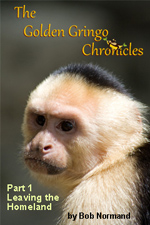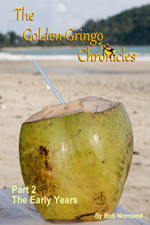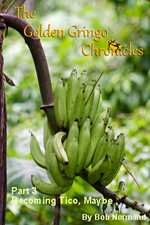The Golden Gringo and the entire staff of GGC Publications (guess who that is) wish you and yours every blessing and good wish for the holidays.
¡Feliz Navidad y Feliz Hanukkah Amigos!
Broken News
(All the News That's Fit to Reprint)
Wages Up & Bus Fares Down
The Costa Rican minimum wage is not a single figure; different minimums are set for a wide range of jobs and specific industries, literally a couple of hundred different jobs. Those not on that list are covered by another, grand average number. A large percentage of workers in the country are paid at the minimum wage level; some sources say it's as high as 70%. World Bank data puts the overall minimum wage in Costa Rica at $6,586 per year. For perspective, it also lists the U.S. at $15,050. On a realized total per capita income basis, Costa Rica is listed at $6,810 and the U.S. at $47,390.
Examples from the list: Skilled worker, per 8-hour day: 10,630.08 colones (about $20.05). Also listed is a University Graduate at 615,083.39 per 26-day month ($1,160). For a typical 8-hour day, 6-day week (or 26 days per month), a minimum wage skilled worked would make 276,382.08 colones (about $521.50) and a university grad would be 615,083.39 (or about $1,160.50). Note that a typical work week here is six 8-hour days.
The Costa Rican government adjusts the minimums twice per year, at the beginning of the year and mid-year. The government recently announced that the increase in minimum wages for January 1, 2016 would be 0.67%. For a minimum wage skilled worker that equals a monthly increase of 1,851.76 colones ($3.49) and for the university grad the increase would be 4,121.06 colones ($7.78). Don't spend it all in one place amigos.
 I've always been a bit amused at the way the government calculates things to eight significant figures here, like the University Grad example above carrying the figure out to 615,083.39 colones (.39 colones equals 0.07 U.S. cents
I've always been a bit amused at the way the government calculates things to eight significant figures here, like the University Grad example above carrying the figure out to 615,083.39 colones (.39 colones equals 0.07 U.S. cents
I first noticed the Tico love of figures when I got my cédula (residency card). In the U.S. with nine figures worth of people we have nine figure social security numbers. Here, with seven figures worth of people we have twelve figure cédula numbers. Go figure (sorry, I couldn't resist using that phrase).
And paying the Caja online (health department) was not to be out done by immigration; the Caja gave me a 15 digit number for that purpose (701430098935998) in addition to the cédula number. Thank God that my computer can remember numbers - click 7 on the appropriate entry field and the whole number pops up (well, almost; actually two numbers pop up to choose from, the caja one and my six digit identifier that starts with a 7 that I use for paying the electric bill).
While the labor department was fine tuning it's semi-annual wage number, November 1 brought a downward adjustment in bus fares across the country. In Quepos, the bus fare for the Quepos/Manuel Antonio route went from 320 colones to 310 (that's down 3.12500000%) but that doesn't seem to fully reflect even partially the changes in oil prices in the last few years. When I moved here in 2008 the bus fare was 160 colones and it rose to 320 by 2014. The international price of oil peaked at around $100 per barrel in 2010 and has dropped slowly but steadily, recently to about $45, a 55% decline. Yut the bus fare went down only 3%? It must be those fabulous wage increases, caused by the minimum wage adjustment mentioned above, which the bus drivers received that really drives the price of a bus ride (yes, I'm being cheeky).
But how can the Golden Gringo complain; as an anciano with a cédula (anciano = old dude over 65 - the more genteel Spanish word is "mayor"), I don't have to pay local bus fares at all. It's a freebie for ancianos (ha, ha, ha, ha, ha, ha, ha, ha, ha, ha, ha, ha, ha, gracias amigos).
Last Naked Tica
 Last naked Tica to be published, that is. Many people, particularly the male half of us and particularly the part of that half who grew up in the '50s and '60s, noted the recent announcement by Playboy Magazine (the first edition was December 1953 and it became popular also in the '50s and '60s) that they will no longer depict models in the nude.
Last naked Tica to be published, that is. Many people, particularly the male half of us and particularly the part of that half who grew up in the '50s and '60s, noted the recent announcement by Playboy Magazine (the first edition was December 1953 and it became popular also in the '50s and '60s) that they will no longer depict models in the nude.
Pundits suggest that the magazine couldn't compete with the instant nudity available on the internet. I guess we'll just have to make due with Playboy's stunning editorial prose (uh-huh). Chin up Heff, we'll survive even if you don't.
It was interesting to learn that there have been Costa Rican Ticas in Playboy in the past. The last one was Marianela Valverde, shown in the photo right (the Chronicles censors demanded we use a clothed version of Marianela - damn prudes!). Marianela got $18,500 for her nude pose in Playboy in 2011, but most importantly, it got her a lot of attention from the fashion world and resulted in her becoming an international model.
Now, in addition to modeling, Marianela hosts a television show out of San José called "Combáte" or Combat, a program that pits teams of good looking young people against each other in games that require negotiating things like water hazards while battering each other with padded canoe paddles (Costa Rica version of The View).
I wonder if Playgirl is going the same route as Playboy. Damn, there goes my chance again! Hmmm, is Playgirl still around, amigos???
Dumb Headlines Department
Seems I missed an important lecture recently given in the Zapote district of San José. Some "expert" from Spain was featured. His topic? Envejecer es bueno para la salud. Literally: "Aging is good for the health". Really amigo? I came close to signing up for the lecture just to hear the explanation of that comment.
I don't make this stuff up amigos. We report, you decide.
Porous Perimeters
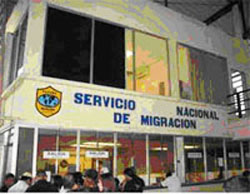 |
Paso Canoas - Costa Rican Side |
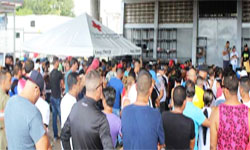 |
Cubans Massed at Border |
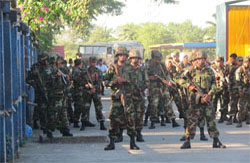 |
Welcome to Nicaragua! |
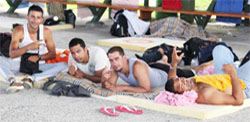 |
Cuban Dudes in La Cruz Shelter |
National borders (called "fronteras" here) are a current topic of concern in many countries today, both because of terrorism and also as a result of drug trafficking. In Central America, and Costa Rica in particular, the countries have been viewed by the drug cartels as an important conduit for moving illegal drugs north from South America into Mexico and then into the U.S. Remember, it's about the same distance from San José to San Diego as it is from Boston to Los Angeles, not very far actually
.
Hardly a week passes here when there isn't a report of an intervention of a major drug shipment on land or sea. In recent years, illegal immigrants (and their handlers, called "coyotes" have begun using the same routes to smuggle people, using Central America and Costa Rica to pass through on the way to the American Dream.
A recent case in point happened in mid-November when 1,600 passport carrying cubans showed up at the Costa Rican/Panama border town of Paso Canoas at the same time. GG has intimate knowledge of this border crossing from using it four or five times in the early days to meet Costa Rican 90-day visa requirements and once also to just do a little shopping in cheaper Panama. A couple of busloads of people dumped on these simple facilities usually causes a significant delay but handling 1,600 at one time? Must have been difficult for everyone concerned.
The Costa Rican border authorities tried to be as humane as possible, bringing in emergency medical care and even food but, as might be expected, they were not able to deal with such an onslaught of people, especially without documents. The next day they thought they had a solution; the immigrants would be issued a "transit visa" which would give them seven days to travel up to the Nicaraguan border and exit there. Problem solved, right? Not.
Two days later (bravo immigrants, that's quite a distance to cover in that time) 1,100 of the Cubans showed up at Peñas Blancas border crossing to enter Nicaragua (another frontera that GG has knowledge of, having passed through it four times) - for more on this border and Nicaragua, go here: Cavorting in Nicaragua. The Nicaraguans were having none of Costa Rica's idea and were definitely not going to issue further transit visas; instead they showed up with a contingent of Army troops in combat gear (see photo right) to block the Cubans entry. Reportedly, they even fired tear gas canisters near the crowd of Cubans to discourage any further advance on their part.
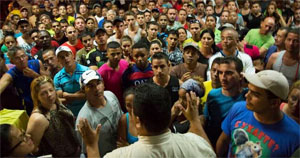 |
Immigration Officer to Cubans: "OK, Does Anyone Have a Valid Document?" |
In the next two days, the Costa Rican government set up migrant shelters, one of them was then housing about 500 Cubans, in the town of La Cruz in the northwestern corner of the country. A deputy director of immigration here noted that “the irregular migration flow of Cubans is not new” and has been growing. Her estimate was that in 2013 there were 500 irregular Cuban migrants, then about 5,000 last year and then through October of this year, some 13,000 (!). On an annual basis, scaled for population differences, that would be like 1.1 million crossing the U.S. border illegally (total apprehensions at U.S. borders in 2014 were about 500,000).
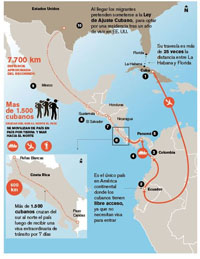 |
Cuban Immigration Route |
This story and Costa Rican concerns about their immigration performance kept growing throughout the second half of November in the aftermath of the terrorist attacks going on around the world. After Honduras caught the five Syrians posing as Greeks, it was disclosed that the five had come through Cost Rica on a transit visa like the Cubans had gotten (a Greek passport in Costa Rica is treated the same as a U.S. or Canadian one).
 Then it was disclosed that the five had stolen passports and were on an Interpol list which was available to CR border agents but, for some reason (some have suggested bribing) the CR border agents didn't check it out (oops). Immigration also reported on November 18th that the number of Cubans held up in Ticoland had risen to over 2,000. Then on the 19th, a sixth Syrian, a lady, was arrested in San Jose with her forged Greek passport. By November 25th, the total number of Cuban "visitors" had risen to over 3,000.
Then it was disclosed that the five had stolen passports and were on an Interpol list which was available to CR border agents but, for some reason (some have suggested bribing) the CR border agents didn't check it out (oops). Immigration also reported on November 18th that the number of Cubans held up in Ticoland had risen to over 2,000. Then on the 19th, a sixth Syrian, a lady, was arrested in San Jose with her forged Greek passport. By November 25th, the total number of Cuban "visitors" had risen to over 3,000.
It was reported also that the Cubans are using the "coyotes" to help them with their travel. Coyotes are the same people who facilitate the travel of other people that ended up as illegal immigrants in the U.S. Although Cuba may be 90 miles off the Florida coast, to get there via coyote transport requires a journey of over 4,600 miles as shown on the map above, right. Reports say that the coyotes are paid $7-10,000 for each person. Nice business. eh.
Towards the end of November foreign ministers from Central American countries, Ecuador, Columbia and Mexico met in El Salvador to try and solve the crisis. Nicaragua gave a slap in the face of the others by sending only a deputy foreign minister. The eleven countries other than Nicaragua came to an agreement to allow the Cubans to go forward and head for the U.S. border. Just how that will be done is in question although some talk of direct transport by boat to Honduras was mentioned.
So now what, amigos? Who knows, more will be revealed, stay tuned.
Quepos Quickies
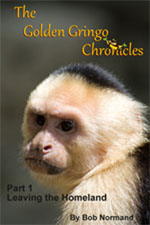 GGC Distribution Over 600. GG is happy to report that distribution of the Golden Gringo Chronicles achieved a new high in November, exceeding 600 (the count at press time was 611). Part of the reason is the adoption of our new emailing system, MailChimp which we installed in October 2014 when the distribution count was 359.
GGC Distribution Over 600. GG is happy to report that distribution of the Golden Gringo Chronicles achieved a new high in November, exceeding 600 (the count at press time was 611). Part of the reason is the adoption of our new emailing system, MailChimp which we installed in October 2014 when the distribution count was 359.
Prior to MailChimp, using Outlook only, we were limited to 100 copies per email, requiring multiple emails and copying of content several times. MailChimp also allows direct sign-up from our new website (www.goldengringo.com) and the development and issuing of "campaigns", i.e., monthly edition notices (the email you receive) so all the effort outside of designing the edition itself, is readily contained in the MailChimp system.
MailChimp, duuude, even the name fits our motif!
¡Pura Vida!
Rumble Talk
(Shaky Happenings On or About the Pacific Rim)
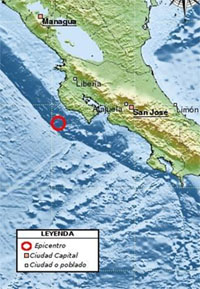 Another relatively quiet month, at least in Costa Rica. The largest quake in Costa Rica in November occurred on November 11 early in the morning. The epicenter was in the Pacific Ocean 50 kilometers (30 miles) west of Samara on the Nicoya peninsula (red circle on map). Although that was quite a distance from land, the 5.2 Richter tremor was felt all the way into the central valley and San José.
Another relatively quiet month, at least in Costa Rica. The largest quake in Costa Rica in November occurred on November 11 early in the morning. The epicenter was in the Pacific Ocean 50 kilometers (30 miles) west of Samara on the Nicoya peninsula (red circle on map). Although that was quite a distance from land, the 5.2 Richter tremor was felt all the way into the central valley and San José.
The fact that it was a rather shallow epicenter, 10 kilometers may have had something to do with it being felt so far away. In contrast, the September 2012 shaker, the second strongest in Costa Rican recorded history at 7.6R, was 41 kilometers deep. On the logarithmic Richter scale which measures energy release, 7.6 is a multiple of 5.2. actually about 140 times the strength of a 5.2. Had the 7.6, also centered near Samara, been only 10 km deep, God knows what would be left of Puntarenas and the towns surrounding it.
Well, that was all to report until 4:34 PM on Saturday, November 21. GG had just laid down for his traditional 20 minute daily siesta when the bed started to shake and roll. It only lasted about five seconds but there was no mistaking that it was a terremoto. The U.S.G.S. reported shortly thereafter that the epicenter of the 4.5R quake was in Ciudad Cortes, a town in the mountains some 85 kilometers (about 50 miles) south of Quepos as the buzzard flies. It also was a rather shallow shaker at 14 kilometers.
Such is life living on the Rim.
Check Out Recent Earthquakes Around the World
Posted by the U.S. Geodetic Survey: Today's Quakes |
¡Solo Bueno!
¿Que Es Eso? Department
(What is This?)

So there I was in a restaurant in Manuel Antonio one morning when a lady reached into a bookcase to pull out some books and all of a sudden shrieked. In the corner of the bookcase was this little fella (actually a medium sized one for its type) curled up in the corner.
Care to guess what it is in that corner? (sorry for the bad photo).
No, it's not Iguana droppings, "It's Alive, It's Moving!!!"
Answer is in What's-in-a-Word section below.
Golden Gringo Chronicles Archives Search
You can use our Archives to explore over 170 feature articles of the Golden Gringo Chronicles plus find Broken News items and ROMEO restaurant reviews. Enter your topic or item to search for in the Google Search Routine below and follow the links offered from the search results. Suggestion: Enter only a simple and precise keyword or two in order to narrow the number of references retrieved:
Golden Gringo Chronicles - Search Here
Christmas in Costa Rica
(Feliz Navidad)
This will be the Golden Gringo's eighth Christmas in Costa Rica. There is no disputing someone's personal preference as to where to live but while you're sitting by the fireplace with care having your hot toddy and watching the snow fall, GG will be sipping fresh coconut water sitting under an umbrella at Manuel Antonio beach. Yeeesss.
Here are some of the more common differences in Costa Rican tradition and culture one finds here during Christmas time:
Aguinaldo
 This is the Christmas Bonus mandated by law that must* be paid to all employees by December 5. It is equal to the average salary or wage paid during the previous twelve month period ending on November 30. Essentially it is a thirteenth month wage or salary payment. GG found this to be a common practice in Europe also. Without the aguinaldo, Christmas would be leaner for both workers and merchants.
This is the Christmas Bonus mandated by law that must* be paid to all employees by December 5. It is equal to the average salary or wage paid during the previous twelve month period ending on November 30. Essentially it is a thirteenth month wage or salary payment. GG found this to be a common practice in Europe also. Without the aguinaldo, Christmas would be leaner for both workers and merchants.
* This payment is not as universal as the law implies. GG recently read government statistics that stated that almost 50% of the workforce in Costa Rica are in the "informal" segment, meaning I suppose, that these people are not under "the system". If anyone in this group receives an aguinaldo it would only be from the generosity of the employer.
For those of you who get it, don't spend your Aquinaldo too fast amigos, because there are some government "requirements" that will take some of your cash back, to wit:
Marchamo
This is the obligatory annual 'liability' insurance and registration that must be carried on all vehicles in Costa Rica. Some think is a way for the government to fund the national insurance company (Instituto Nacional de Seguros or INS).
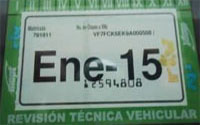 The marchamo must be renewed annually between November 1 and December 31. A car without the correct marchamo decal on the windshield after the 1st of January is deemed illegal. In that situation, police are empowered to seize your plates and impounded the car and sometimes do. The Marchamo cannot be paid if there are any outstanding parking or traffic tickets issued against the car during the year. You must also have an up-to-date annual inspection certificate to get the Marchamo.
The marchamo must be renewed annually between November 1 and December 31. A car without the correct marchamo decal on the windshield after the 1st of January is deemed illegal. In that situation, police are empowered to seize your plates and impounded the car and sometimes do. The Marchamo cannot be paid if there are any outstanding parking or traffic tickets issued against the car during the year. You must also have an up-to-date annual inspection certificate to get the Marchamo.
You get an updated inspection certificate at one of the 13 RITEVE locations around Costa Rica. RITEVE (Revisión Técnica Vehicular) is a private company with a government contract. This currently costs $20 before paying for any corrections or changes required by RITEVE but the company has requested of the government a 205% increase in the fee to $61, but they probably won't get that much. RITEVE stickers can and must be obtained in a specific month, like in the U.S., or just before paying your Marchamo if you've somehow avoided the Transito police since your RITEVE sticker expired. Late breaking report - fee increase was rejected by ARESEP, the government's rate controlling entity "because there is no approved system for calculating the fee". Whatever.
The government makes it convenient to pay the Marchamo fee by accepting payment at MOPT offices (Ministerio de Obras y Publicas y Transportes - Tico DOT if you will), at banks and licensed private payment centers (these are also often used to pay Caja health care and utilities).The amount of the Marchamo depends on the year, make and model of the car. One report had it that a 17 year old car recently needed to pay more than $200 whereas an expensive modern car might be in excess of $700.
(Once more GG applauds himself for deciding when he moved here seven years ago, after 50 straight years of car ownership in the U.S., for not buying and operating a car here. Pura Vida.)
Black Friday
Assuming you have some cash left over after negotiating the financial hazards of RITEVE and paying your Marchamo, you may now be ready to buy some Christmas presents.
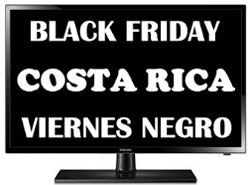 Merchants in Costa Rica have recently (2011) adopted a black Friday (and weekend) somewhat modeled after the U.S. commercial tradition of the same name. The last weekend of November has been dubbed Viernes Negro and merchants offer a wide variety of products. Discounts of 40-70% are not uncommon.
Merchants in Costa Rica have recently (2011) adopted a black Friday (and weekend) somewhat modeled after the U.S. commercial tradition of the same name. The last weekend of November has been dubbed Viernes Negro and merchants offer a wide variety of products. Discounts of 40-70% are not uncommon.
At the bigger malls, like in San José, you might also find raffles for cars, cash, vacation trips and other large prizes. Some banks offer their customers credit cards as a reward when making purchases to kick off the holiday shopping season. Like in the U.S., shoppers literally stalk the store openings in an attempt to get the best deal on a product before supplies run out.
Go for it, amigos!!! GG, however, will be home watching It's a Wonderful Life with Ji...Ji...Jimmy Stewart.
Portal
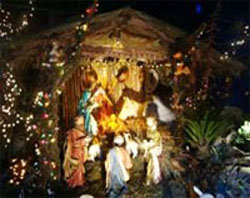 But Christmas is not all about money and Marchamo stickers. It's also a very important holiday to Christians, and Costa Rica is very Christian, very Catholic. Beginning in November you start to see portales (plural of portal) pop up in homes and shops. A portal is what we would call a manger scene or crèche.
But Christmas is not all about money and Marchamo stickers. It's also a very important holiday to Christians, and Costa Rica is very Christian, very Catholic. Beginning in November you start to see portales (plural of portal) pop up in homes and shops. A portal is what we would call a manger scene or crèche.
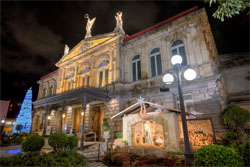 |
The Portal at Teatro Nacional |
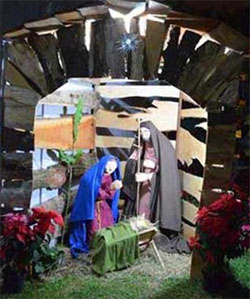 |
An Artsy Portal |
Costa Ricans go to great effort in designing and making their portales personal, decorating the statues with ornate clothing sometimes using antique carvings or castings of people and animals. The more devout (or competitive) will display their portal in an area where passersby can view it. The cradle where Jesus is placed in is held empty until Christmas eve when it is then filled with the Christ child.
Portals can be elaborate, classic or artsy. The most elaborate one in Costa Rica is usually the one constructed at the Teatro Nacional in the heart of San José. It has taken on various themes in the past, from jungle scenes to desert scenes. The theme of this particular crèche (it might be called the national portal) is a state secret (or at least a capitol secret) until it's constructed in late November. There are limits to the theme however; someone once suggested a Star Wars portal but that idea was vetoed (Chewbacca in a manger?, c'mon).
At Christmas time In Costa Rica, the gift-bringer is often 'Niño dios' (Child God, meaning Jesus) or 'Colacho' (another name for St. Nicholas). Family and friends gather on Christmas Eve and, after exchanging gifts, usually go to Misa de Gallo (Mass of the Rooster), or midnight mass. That's followed by gift exchanging and a large dinner (nothing like dinner at 2 in the morning - reminds me of Spain). OK amigos, then bring on the food.
Food
 |
A Corn-Wrapped Tamal |
 |
A Banana Wrapped Tamal |
 |
Dude! |
Now we're talking. Most likely two things will appear during the Christmas meal, some form of pork and my favorite xmas food, tamales. Baked pork leg is often a special offering at this holiday and is delicious (I've sampled my landlady's and I'm plotting for another invite).
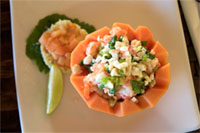 |
How About a Shrimp Remoulade Served in a Papaya Shell or... |
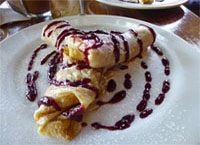 |
Mango Stuffed Pancakes
With Raspberry Sauce |
Tamales appear all over town during the Christmas period and, in GG's opinion, are delicious. I had never tried them before moving here but now I'm a devotee and look forward to them at Christmas. There is a science in the way that these tasty morsels are produced and plenty of room for creativity in their ingredients. To see how to make these latino favorites in the Costa Rican style, go here: Tamales.
Eggnog is a traditional and very popular drink at Christmas time here. The typical recipe calls for milk, cream, sugar and egg yolks. It is flavored with rum and spiced cinnamon, nutmeg, coconut and optionally, vanilla. The last two ingredients are produced and available locally.
It's been noted several times in the Chronicles that Costa Ricans love fiestas of all kinds. December and Christmas are no exceptions. Throughout December and into January, there are many fiestas, rodeos, neighborhood parties, bull runs (no swords or pics, they just taunt the hell out of the bull and cause it to have a nervous breakdown), choral performances and dances.
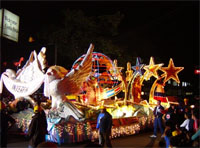 |
Festival of Lights |
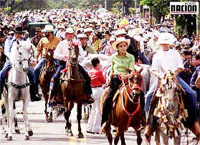 |
Tope Nacional |
For example, in San José there is a festival of lights (kicks off the Christmas season) that is a parade of elaborate, lit floats and dancers (who, I suspect, also a bit lit). Another popular parade is the Tope Nacional (occurs the day after Christmas), which is a horse parade that attracts thousands of riders from all over the country as well as hundreds of thousands of spectators, Great care is taken to maintain municipal cleanliness and not to leave behind a large, long trail of horse you-know-what. Parades and topes also go on in many other towns around the country on a smaller scale.
The week between Christmas and New Year's is also primary vacation time for Ticos and many choose going to the beach. Manuel Antonio beach (Playa Espadilla) becomes very busy with "comehuevos" (nickname for people from the central valley) pitching tents and competing for the limited chairs and umbrellas offered by our friendly beach vendors. GG usually chickens out during this week and leaves the entire beach to the visitors, God bless 'em.
 |
 |
Your Santa |
My Santa |
OK, amigos, will it be your Santa or mine?
¡Solo Bueno!
The Malecón
(Dam Good Life)
It's been pointed out before in the Chronicles (Edition 42, Edition 87) that the town of Quepos was originally built by filling in existing swamp land with the rubble caused by blowing up parts of the two mountains on either side of what is now the city.
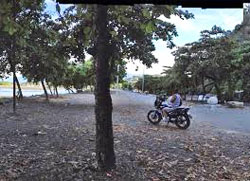 |
Top of the Malecón Looking North |
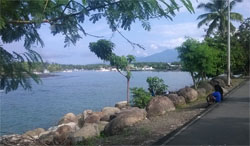 |
View Malecón to Port Quepos |
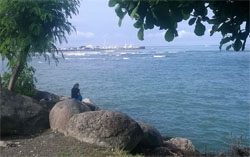 |
View Malecón to Marina Pez Vela |
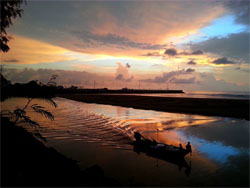 |
View from the Malecón at Sunset Looking Across the Boat Channel Towards Pez Vela Marina |
At the same time, a dyke was constructed across the western or water side of this filled-in, town-in-the-making to keep out Pacific storms and, God forbid, a tsunami if necessary. We locals call this dyke, or dam if you will, the malecón (mal-ay-cōne) which is the Spanish word for pier or jetty which are other words for a dam or dyke. The dyke was built using huge rocks on the water side so it provides a strong buffer against waves that hit it at high tide.
On a normal day the top of the malecón is from 20 to 30 feet above the water level, depending on the tide. A boat channel runs south from port Quepos, which is located a half kilometer north of the malecón, then along the malecón, then it turns west and out to sea after passing by Marina Pez Vela. At low tide, tall surfers can and do literally walk across the channel from the malecón onto a sand bar that forms the southern tip of Cocal beach. There they go surfing in the Pacific.
The story is told that in the past, before Marina Pez Vela was constructed, one could catch a curl a little south of the marina and run it for more than a mile all the way up Cocal beach. Although the marina may have interfered with some of those waves, there are still some long, slow curls, the kind that surfers favor, running from the north end of the marina up to Cocal.
We have a tsunami alarm at the firehouse in downtown Quepos but I've only heard it once in the more than seven years I have lived here; it was a test. Of course, if the tsunami were to be large enough, say more than a 10 meter wave (33+ feet), we downtowners might all kiss our collective nalgas goodbye (see What's-in-a-Word below for the meaning of the Spanish word "nalga"). Or maybe we could run up the hill of the old half-blown away mountains (that's GG's contingency plan as I live about two blocks from the bottom of one of those hills).
But tsunamis can get very big, the current record being a 50 meter/165 foot giant that hit Sumatra in December of 2004 that killed more than 230,000 people. For photos of that unbelievable wave see Tsu, Tsu, Tsunami.
Sunsets at the malecón, like anywhere along our coasts, can be spectacular. It is a place to go to be at peace with one's self and embrace a great display of natural beauty. My only complaint is that there is a lack of benches along the malecón to help people enjoy the beauty there (it could use a few more shade trees also). Come on my Canton de Quepos buddies, can't we squeeze enough out of the budget to put up about 10 of those infamously uncomfortable 3-seater cement benches?
Yet there have been significant improvements in the appearance of the malecón in recent years.
The inside of the dyke hill, the part that runs along the dyke in between the street-level sidewalk and the access road at the top of the dyke, has been cleaned up and landscaped - a great improvement. And interspersed with the landscaping are a number of art works such as stone releif carvings depicting area heritage. In addition, the cement benches at the bottom of the dyke on the street side have had their seat backs enhanced with some colorful tile work. The montage below shows what I'm talking about.
Another shortfall at the moment is lighting - there are no street lights along the malecón so it is strongly recommended to anyone visiting our area not to stroll across the malecón after dark. It can be a gathering point in the night for those you wouldn't do business with during daylight and it's good to remember that the malecón is only a block or two from most of the major watering holes of Quepos.
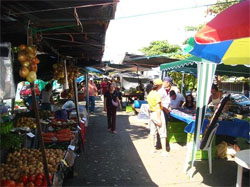 Another use for the malecón is when it comes alive on Fridays and Saturdays for the feria or farmers market, which runs typically Friday afternoon and evening and Saturday morning. If you love the fresh fruits and vegetables of Costa Rica as much as I do, you won't find a place with more variety than the feria.
Another use for the malecón is when it comes alive on Fridays and Saturdays for the feria or farmers market, which runs typically Friday afternoon and evening and Saturday morning. If you love the fresh fruits and vegetables of Costa Rica as much as I do, you won't find a place with more variety than the feria.
For the first two years that I went to the feria it seemed as though I found a new tropical fruit there every week. There are mangosteen, cas, grenadilla, pejibaye, guanábana, mamones and many more as well as the standard bananas, pineapple, papaya and several types of melons.
For a quick walking tour of the feria, our friends at Villas Jacquelinas have provided, via Youtube, an excellent four minute video about the malecón; see it here: https://youtu.be/JIOnz_NvEWw.
The feria was moved to the malecón from downtown Quepos a few years ago. When in session, it currently runs about 200 meters along the top of the dyke with vendors' stands on either side of a walkway. Vendors find it easy to setup their products at their stands because the top of the dyke is a paved access road (not usually open to the general public) that runs the entire length of the malecón. In addition to a marvelous assortment of fruits and vegetables you're liable to find a few chicken purveyors, a couple of sellers of common and exotic herbs and a few handicraft artists. Often there are musicians in the background playing, for tips, xylophones, flutes or other instruments.
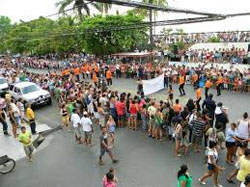 |
Fiesta in Progress On the Street in Front of the Malecón |
The renovated malecón on the street side also provides a backdrop for various fiesta activities. Hardly a day passes in Costa Rica without some kind of fiesta going on and we have our share in Quepos. The street-side center of the malecón includes a small performance stage (behind the booth in the picture to the left) for performances of various kinds (it's being used for viewing by people in the photo to the left).
Not shown in the picture is a gazebo-like structure to the right of the stage where you can almost always find a number of locals engaged in heated chess, checkers or parcheesi competition whilst they solve all the political and social problems of the metropolis of Quepos.
So you can see that the malecón is a central part of local culture and just a nice dam place to hang out.
¡Pura Vida!
TOP
Respecting Regional Reptiles
(The Snakes of Costa Rica)
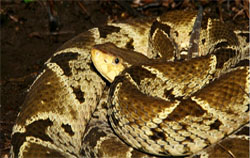 |
Curled Up Terciopelo |
Just the mention of snakes to some people will bring on a very nervous reaction, and actually seeing one sometimes brings on hysteria. GG thinks his own personal reaction is somewhere in between nonchalance and nervousness; I just don't like being around a snake if it's not in a case or cage.
There are approximately 2,900 species of snakes in the world and Costa Rica boasts 139 of them or about 5% of the total. This falls in line with naturists' estimates that Costa Rica, with .3% of the land area on the globe, has about 6% of its bio diversity (an out-of-balance ratio of 200 to 1). The 139 types of snakes represent 60% of all the species of reptiles in the country.
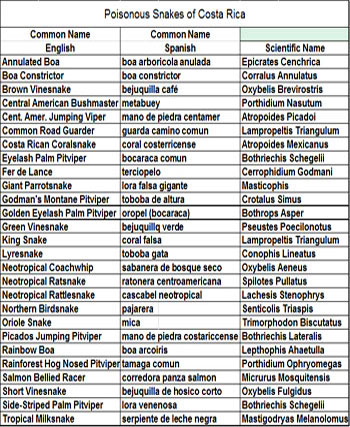 At least twenty-two of Costa Rica's snake species are known to be venomous or poisonous (some sources list 26). Two-thirds of these are vipers (family viperidae) and the rest are elapids (family elapidae). The vipers are found in tropical and sub-tropical regions around the world while the elapids are found in many more climates as well as tropical and have a larger number of sub-species. The elapid family even includes the Egyptian cobra.
At least twenty-two of Costa Rica's snake species are known to be venomous or poisonous (some sources list 26). Two-thirds of these are vipers (family viperidae) and the rest are elapids (family elapidae). The vipers are found in tropical and sub-tropical regions around the world while the elapids are found in many more climates as well as tropical and have a larger number of sub-species. The elapid family even includes the Egyptian cobra.
The terciopelo shown in the ¿Que Es Eso? section above (oops, I gave it away) that surprised a friend recently is reportedly responsible for the largest number of snake bites in the country and they can be fatal. The good news is that the Costa Rica health care system maintains one of the largest anti-venom inventories in the world.
The mortality rate for snakebite in Costa Rica 50 years ago was 4.8 per 100,000 but had dropped considerably by the early nineties. The health system here has developed an extensive system of anti-venoms that has gone a long way to keeping this problem under control.
It's obvious to the most casual observer (love that phrase - I stole from a Calculus II theorem proof back in 1962) that there are too many poisonous snakes for the on-experts to be able to differentiate between them or identify them positively. For us amateurs, it is always best to just assume the snake you meet is poisonous and treat it accordingly, with great respect
.
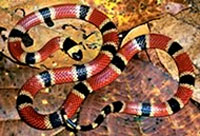 |
Costa Rican Coral Snake |
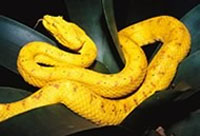 |
Eyelash Pit Viper |
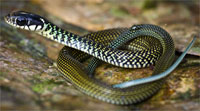 |
Speckled Racer
(Non-Poisonous) |
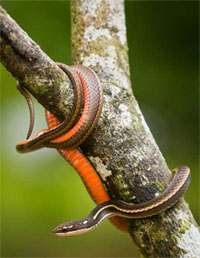 |
Salmon Bellied Racer
(Poisonous) |
Other Costa Rican snakes will give you a bad bite that can be painful but need not be poisonous. The pretty spotted and Speckled Racer shown to the lower left is one of those that will bite but has no venom. His cousin, the Salmon Bellied Racer (photo just below the Speckled Racer) on the other hand is venomous.
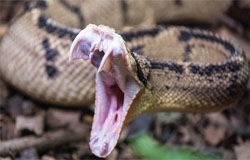 |
Central American Bushmaster
(How 'bout Those Fangs) |
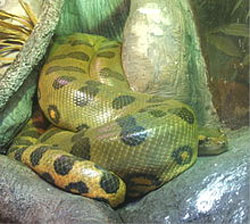 |
Green Anaconda |
 |
John Voight in Anaconda the Movie |
The largest poisonous snake in Costa Rica is the Central American Bushmaster. The literature says that the Bushmaster is also the largest poisonous snake in the "New World" (I presume that means the Americas) and can reportedly reach a length up to 3.6 meters (12 feet) and weigh up to 5 kilos (11 lbs). Their diet in the wild is primarily small mammals and in captivity they are usually fed domestic rats. (uuurp)
As nasty as the Bushmaster seems and is, it is not the largest snake in the world. That honor goes to the Green Anaconda or Water Boa found in the Amazon region. This non-poisonous reptile has been reported to reach verified lengths greater than 5 meters (18 feet). It is also considered the heaviest snake in the world and can reach weights up to 70 kilos (150+ lbs). Anacondas longer and heavier than even that have often been "reported" or "sighted" by various people including natives but they have never been "verified".
The mystique and legends about the Anaconda are very strong and even gave rise to a fictional movie in 1997 called, not surprisingly, "Anaconda" starring, among others, Jennifer Lopez and John Voight. At one point, voight gets eaten by a huge anaconda and shortly thereafter someone or something causes the snake to regurgitate him. Voight comes popping out wrapped in slimy snake juice and with one eye open with which he teasingly winks at the camera. I love movies with a happy ending and laughed like hell at that one.
I noticed something interesting when visiting the Quepos Hospital recently. They keep a large record posted on the wall near the farmacia of all the types of treatments that they administer, comparing the last several years by year. The first thing I noticed was a sharp drop in the number of dengue cases in recent years (2011 through 2015 year-to-date). I attributed that to the weather trend we've experienced in the recent period starting with a 50-year rain event in 2010 and tapering off after that. During that same period, the number of treatments for snakebite at our hospital dropped from 55 to 12 (Sept. 1 year-to-date). Seems drier climes slow down the terciopelos. That's supported by known statistics that show a much lower incidence of snakebites in Guanacaste, where the climate is drier, than in the rainforest.
But remember, there are no real rules that guide one to decide whether or not a snake you encounter in Costa Rica is poisonous or threatening. So unless you're an expert by past experience or a herpetologist (i.e., a technical expert on snakes), the best policy when you meet up with a snake in Ticoland is to give it wide latitude and move along.
¡Solo Bueno
Travel Quote of the Month
Southwest Airlines again: "As you exit the plane, please make sure to gather all of your belongings. Anything left behind will be distributed evenly among the flight attendants. Please do not leave children or spouses." |
What's-in-a-Word
Answer to Que Es Eso
It's one of Costa Rica's most poisonous snakes, a terciopelo, also known as a fer-de-lance.
Terciopelo
Literally this means "one-third skin" but the word is normally translated as "velvet", the snake getting this latter name, I suppose, for it's smooth skin (I really can't say as I've never personally petted one). The terciopelo belongs to the Bothrops Asper family and goes by other names: fer-de-lance, barba amarilla ("yellow beard", in Guatemala and Honduras), equis ("X" in Ecuador & Panama), taya equis (Colombia), nauyaca ("four noses" in México; from the Nahuatl language), and yellow-jaw tommygoff (Belize). (oh I say, tommygoff is a rather lovely way of saying snake, eh what? Cheers to the Brits in Belize!)
Nalgas
This is the plural of nalga which means buttock or butt. A local porteador taxi driver I see most mornings at the bus station always asks if I'm going to the beach to "broceada sus nalgas", that is, tan your butt? I think he's jealous of my retirement status, but he's a nice guy.
Black Friday
The name was first associated with bad financial times in the United States and, in particular, the financial crisis of 1869.
In the early 1960's it became associated to the day after Thanksgiving, historically one of the busiest retail shopping days of the year. Many consider it the "official" beginning to the holiday season. Most retailers will open very early and usually provide massive discounts on their products.
The use of the word "black" has several references. It relates to business accountants traditionally recording losses in red ink and that heavy sales day turning the corner on a year's profit. It also has been used derogatorily by law enforcement to describe the major traffic jams that often occur because of the large numbers of shoppers on the roads. The idea that it was named after a practice of discounting the sale of slaves after Thanksgiving has been discredited.
Snooze-You-Lose
I was sitting with a tico friend recently, a man who is well conversant in both English and Spanish and teaches both, when I used an old gringo saying: "If you snooze, you lose". I asked him how you would say that in Spanish and he said: "Camarón que se duerme, se lo lleva la corriente". Literally: "A shrimp that sleeps is taken away by the current". Yup, that works too.
TOP
ROMEO Corner
(Retired Old Men Eating Out)
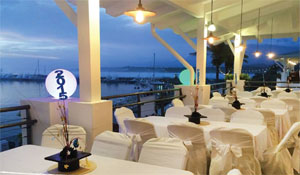 Mercato di Porto
Mercato di Porto
Location: Marina Pez Vela
Hours: Lunch and Dinner (till 10 PM)
Parking: Ample in the Main Parking Garage
Contact: Tel.: 2519-9091;
Email: info@mercatodiporto.com;
Website: mercatodiporto.com (one picture page only).
Reviewing ROMEOS: Cheryl B., David B., Mary M., Lance M., Brian M., Tom O., Bob N.
To Review Our Rating System and Procedure, go here: R.O.M.E.O. Rating System
This is one of four restaurants at Marina Pez Vela in Quepos. The other three ("Z", Gabriella's and Runaway Grill - visited when it was El Gran Escape) have been reviewed by the ROMEO's in the past.
Mercato di Porto is located on the second level, front of the marina and provides an extensive view of the port and the Pacific. Almost all the tables line the edge of the balcony to get this view. The tables on the night of the review were decorated with simple table cloths and little else (the photo above was taken during an event, New Year's 2015). For atmosphere we give Mercato 4.5 sloths.
The restaurant bills itself as Italian Gourmet. It's menu offers an eclectic combination of everything from pizza to paninis to pasta to meat dishes, all with an Italian flare. In the early days the restaurant offered a deli with Italian meats and chesses but I didn't see any sign of that this time; the cases previously used for those items now contain beers and wines being cooled.
Some of the appetizers we ordered included breaded artichokes and other vegetables and a bruschetta, all tasty if not exceptional.
GG ordered a tagliatelle with shrimp and sausage in a fresh basil pomodoro sauce. Very tasty.
The other six ROMEOS ordered a variety of dishes from panini sandwiches to pasta to pizza to chicken marsala. All were appetizingly presented and declared from good to excellent in taste.
The height of the meal occurred when a nutrella pastry was offered by the server and several of us took him up on it. A freshly baked nutrella pastry (allow 15 minutes extra for it to be cooked on order) oozing with chocolate and served with vanilla ice cream on the side was presented and appreciated by all who ate it.
|
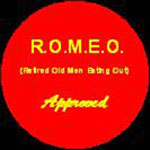 |
.jpg) 1/2 1/2 |
$$$$ |
Value Index = 113 |
We give Mercato di Porto five sloths for food quality.
Service was friendly and mostly efficient but there was an incorrect bill presented to two ROMEOs (a couple) that had to be changed, which was promptly done. Four sloths for service.
For atmosphere, food quality and service we give Mercato di Porto an average of 4.5 sloths.
The bill presented for GG's bruschetta, tagliatelle, nutrella dessert, one coke and one coffee was slightly over 20,000 colones or $38. That puts Mercato di Porto in the top 20% of costly restaurants in the area and suggests a rating of 4$ for expense. The Value Index for this restaurant is, therefore, 4.5/4x100=113.
Mercato di Porto represents a good dining experience at a typical area price and can carry the ROMEO seal of approval.
Golden Gringo Chronicles Novel and E-Books Now Available!
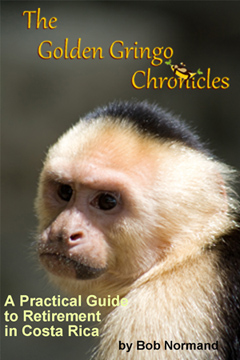 The story of the Golden Gringo Chronicles is also available as a hard copy novel of 192 pages available through Amazon and all major online retailers. ($9.95)
The story of the Golden Gringo Chronicles is also available as a hard copy novel of 192 pages available through Amazon and all major online retailers. ($9.95)
Amazon link: GGC, the Book. (Kindle Edition available)
Follow GG through the first six years of his odyssey in making the decision to retire in Costa Rica, overcoming the trials and tribulations of moving and obtaining residency there and the fun and experience of actually living in Ticoland.
Ride along with the Golden Gringo as he learns about the rich, varied culture of Costa Rica, the incredible bio diversity, the charming nature of the Costa Rican people and the ease with which a sometimes clueless ex-pat can assimilate into a small southwestern town on the Pacific coast.
Whether you are already a Costa Rican resident, someone contemplating a move here or just a traveler who enjoys different cultures, you will find the Golden Gringo Chronicles interesting, entertaining and informative about Costa Rica.
A narrative version of the Golden Gringo Chronicles is now also available as a trilogy of E-books in formats compatible with virtually all electronic platforms.
Part 1: (FREE!)
Leaving the Homeland
Part 2: ($3.99)
The Early Years
Part 3: ($3.99)
Becoming Tico, Maybe
Click on Part Number above for E-book sample downloads or click the price above right for purchase. (The best price is on Part 1; it's FREE)
Opt-In Here to Receive Your Free Copy Monthly
The Golden Gringo Chronicles is a free newsletter that is non-political, non-commercial and, hopefully, entertaining. By signing up you will receive an email each month around the first of the month giving you the links to the latest edition as well as to each individual feature and departmental section.
CLICK HERE TO SIGN-UP FOR THE
GOLDEN GRINGO CHRONICLES
or Email me at gg@goldengringo.com

The Golden Gringo
Pura Vida!
To Contact GGC World Headquarters (yuk, yuk) to make comments, suggest topics or criticize my bad jokes, just send an email to: bob@bobnormand.com.
Be pithy but kind; I'm sensitive.
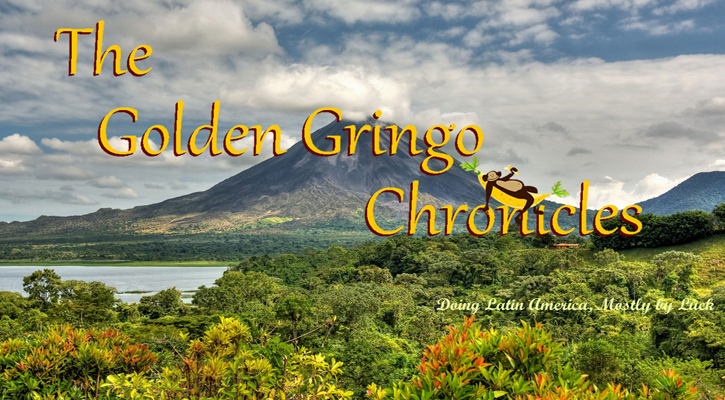


 I've always been a bit amused at the way the government calculates things to eight significant figures here, like the University Grad example above carrying the figure out to 615,083.39 colones (.39 colones equals 0.07 U.S. cents
I've always been a bit amused at the way the government calculates things to eight significant figures here, like the University Grad example above carrying the figure out to 615,083.39 colones (.39 colones equals 0.07 U.S. cents  Last naked Tica to be published, that is. Many people, particularly the male half of us and particularly the part of that half who grew up in the '50s and '60s, noted the recent announcement by Playboy Magazine (the first edition was December 1953 and it became popular also in the '50s and '60s) that they will no longer depict models in the nude.
Last naked Tica to be published, that is. Many people, particularly the male half of us and particularly the part of that half who grew up in the '50s and '60s, noted the recent announcement by Playboy Magazine (the first edition was December 1953 and it became popular also in the '50s and '60s) that they will no longer depict models in the nude. 





 Then it was disclosed that the five had stolen passports and were on an Interpol list which was available to CR border agents but, for some reason (some have suggested bribing) the CR border agents didn't check it out (oops). Immigration also reported on November 18th that the number of Cubans held up in Ticoland had risen to over 2,000. Then on the 19th, a sixth Syrian, a lady, was arrested in San Jose with her forged Greek passport. By November 25th, the total number of Cuban "visitors" had risen to over 3,000.
Then it was disclosed that the five had stolen passports and were on an Interpol list which was available to CR border agents but, for some reason (some have suggested bribing) the CR border agents didn't check it out (oops). Immigration also reported on November 18th that the number of Cubans held up in Ticoland had risen to over 2,000. Then on the 19th, a sixth Syrian, a lady, was arrested in San Jose with her forged Greek passport. By November 25th, the total number of Cuban "visitors" had risen to over 3,000.  GGC Distribution Over 600. GG is happy to report that distribution of the Golden Gringo Chronicles achieved a new high in November, exceeding 600 (the count at press time was 611). Part of the reason is the adoption of our new emailing system, MailChimp which we installed in October 2014 when the distribution count was 359.
GGC Distribution Over 600. GG is happy to report that distribution of the Golden Gringo Chronicles achieved a new high in November, exceeding 600 (the count at press time was 611). Part of the reason is the adoption of our new emailing system, MailChimp which we installed in October 2014 when the distribution count was 359.  Another relatively quiet month, at least in Costa Rica. The largest quake in Costa Rica in November occurred on November 11 early in the morning. The epicenter was in the Pacific Ocean 50 kilometers (30 miles) west of Samara on the Nicoya peninsula (red circle on map). Although that was quite a distance from land, the 5.2 Richter tremor was felt all the way into the central valley and San José.
Another relatively quiet month, at least in Costa Rica. The largest quake in Costa Rica in November occurred on November 11 early in the morning. The epicenter was in the Pacific Ocean 50 kilometers (30 miles) west of Samara on the Nicoya peninsula (red circle on map). Although that was quite a distance from land, the 5.2 Richter tremor was felt all the way into the central valley and San José. 
 This is the Christmas Bonus mandated by law that must* be paid to all employees by December 5. It is equal to the average salary or wage paid during the previous twelve month period ending on November 30. Essentially it is a thirteenth month wage or salary payment. GG found this to be a common practice in Europe also. Without the aguinaldo, Christmas would be leaner for both workers and merchants.
This is the Christmas Bonus mandated by law that must* be paid to all employees by December 5. It is equal to the average salary or wage paid during the previous twelve month period ending on November 30. Essentially it is a thirteenth month wage or salary payment. GG found this to be a common practice in Europe also. Without the aguinaldo, Christmas would be leaner for both workers and merchants. The marchamo must be renewed annually between November 1 and December 31. A car without the correct marchamo decal on the windshield after the 1st of January is deemed illegal. In that situation, police are empowered to seize your plates and impounded the car and sometimes do. The Marchamo cannot be paid if there are any outstanding parking or traffic tickets issued against the car during the year. You must also have an up-to-date annual inspection certificate to get the Marchamo.
The marchamo must be renewed annually between November 1 and December 31. A car without the correct marchamo decal on the windshield after the 1st of January is deemed illegal. In that situation, police are empowered to seize your plates and impounded the car and sometimes do. The Marchamo cannot be paid if there are any outstanding parking or traffic tickets issued against the car during the year. You must also have an up-to-date annual inspection certificate to get the Marchamo. Merchants in Costa Rica have recently (2011) adopted a black Friday (and weekend) somewhat modeled after the U.S. commercial tradition of the same name. The last weekend of November has been dubbed Viernes Negro and merchants offer a wide variety of products. Discounts of 40-70% are not uncommon.
Merchants in Costa Rica have recently (2011) adopted a black Friday (and weekend) somewhat modeled after the U.S. commercial tradition of the same name. The last weekend of November has been dubbed Viernes Negro and merchants offer a wide variety of products. Discounts of 40-70% are not uncommon. But Christmas is not all about money and Marchamo stickers. It's also a very important holiday to Christians, and Costa Rica is very Christian, very Catholic. Beginning in November you start to see portales (plural of portal) pop up in homes and shops. A portal is what we would call a manger scene or crèche.
But Christmas is not all about money and Marchamo stickers. It's also a very important holiday to Christians, and Costa Rica is very Christian, very Catholic. Beginning in November you start to see portales (plural of portal) pop up in homes and shops. A portal is what we would call a manger scene or crèche. 














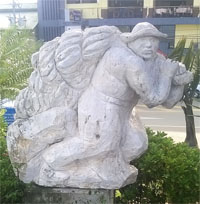
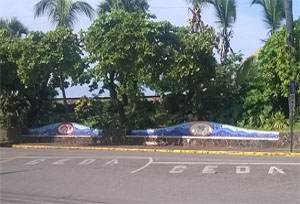
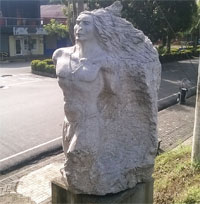
 Another use for the malecón is when it comes alive on Fridays and Saturdays for the feria or farmers market, which runs typically Friday afternoon and evening and Saturday morning. If you love the fresh fruits and vegetables of Costa Rica as much as I do, you won't find a place with more variety than the feria.
Another use for the malecón is when it comes alive on Fridays and Saturdays for the feria or farmers market, which runs typically Friday afternoon and evening and Saturday morning. If you love the fresh fruits and vegetables of Costa Rica as much as I do, you won't find a place with more variety than the feria. 

 At least twenty-two of Costa Rica's snake species are known to be venomous or poisonous (some sources list 26). Two-thirds of these are vipers (family viperidae) and the rest are elapids (family elapidae). The vipers are found in tropical and sub-tropical regions around the world while the elapids are found in many more climates as well as tropical and have a larger number of sub-species. The elapid family even includes the Egyptian cobra.
At least twenty-two of Costa Rica's snake species are known to be venomous or poisonous (some sources list 26). Two-thirds of these are vipers (family viperidae) and the rest are elapids (family elapidae). The vipers are found in tropical and sub-tropical regions around the world while the elapids are found in many more climates as well as tropical and have a larger number of sub-species. The elapid family even includes the Egyptian cobra.






 Mercato di Porto
Mercato di Porto

